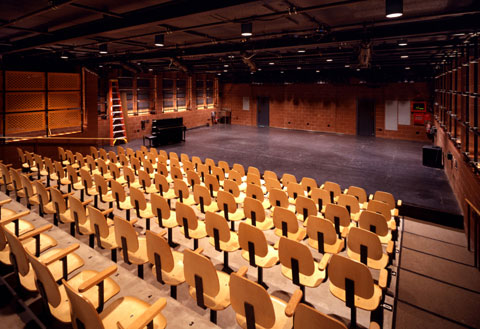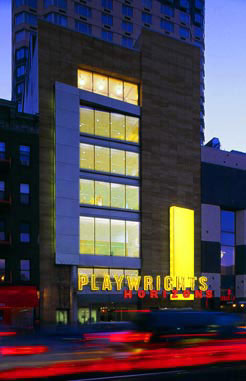
Home · Email · List of Projects · Project Sites and Links · Articles · Robert Davis Biography
Playwrights Horizons - New York, New York

Main Stage

Main Stage

Peter Jay Sharp Studio Theater

Entrance on 42nd Street
Playwrights Horizons was founded in 1971 and has become one of the nation's premier venues for new work. Playwrights has presented new work by more than 300 writers, including Christopher Durang's Sister Mary Ignatius Explains It All For You, A.R. Gurney's Later Life, Scott McPherson's Marvin's Room, Wendy Wasserstein's The Heidi Chronicles, and Alfred Uhry's Driving Miss Daisy. Playwrights produced critically acclaimed musicals such as William Finn's Falsettos and Stephen Sondheim and James Lapine's Sunday in the Park With George.
Playwrights is one of six Off-Broadway theaters along west 42nd Street called "Theater Row". The six new and renovated theaters range from 99 to 199 seats. A 499-seat Shubert Organization theater, the "Little Shubert", is Playwrights' next-door neighbor to the West.
The new Playwrights was built on the same lot as the old Playwrights building, which was vacated for a year during demolition and construction. The old Main Stage is duplicated almost exactly in the new building. The new building increases the seating capacity of the Main Stage auditorium, adds a Studio Theater, and provides a radical improvement in support space. The new facility includes administrative offices, a telemarketing office, one large and one small rehearsal room, dressing rooms, and spaces for stage departments such as carpentry, props, wardrobe, sound, and electrics. The ground floor lobby on 42nd Street includes a new home for Ticket Central, which is a cooperative box office for several theaters.
The building lot is very small so this project is an exercise in artful stacking. Mechanical equipment is located on the bottom and top floors for acoustical and other practical reasons. The left, right, and rear walls are lined with continuous mechanical chases the full height of the building to transfer ducts and conduits from floor to floor. The major spaces are separated acoustically by interstitial noise isolation floors. These noise buffer floors are filled with offices and other similar quiet activities that won't leak noise into the adjacent theaters and that don't mind a little noise leaking into them.
Playwrights was careful not to lose their unique style in the new building. Playwrights decided not to enlarge the stage, but instead kept the tiny stage the same size in the new building that it was in the old building so that their production budgets and their intense small production style would not have to expand or be diluted trying to fill more space in the new facility.
The entire stage floor is trapped, can be removed, and can open completely into the trap room below. The front edge of the stage and the proscenium walls left and right are removable to suit the needs of the performance. The counterweight rigging extends out past the front edge of the stage roughly half way back into the auditorium, so it is possible to stand at the locking rail and operate linesets over the auditorium chairs. The Main Stage is wired with the old data standard DMX, with the new data standard Ethernet, with Wybron data wires for scrollers, and anticipates dimmer-doubling on most of the 192 circuits.
The new Playwrights Horizons opened in 2003. The capital campaign to cover the cost of the building and an endowment is $32 million.
- Main Stage: 199 seats
- Studio Theater: 128 seats
Architect: Mitchell Kurtz Architect PC
Acoustician: Jerry Marshall of Marshall-KMK
Home · List of Projects